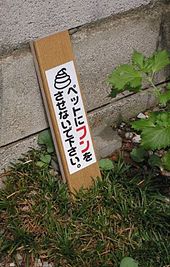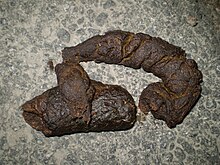Dog poop
Dog excrement (Austrian high German Hundstrümmerl ) is the mostly solid excretion ( excrement ) of the intestines of dogs . There are usually rules for removing dog poop in public areas. The regulation of dog ownership in Germany is a matter for the municipalities . Usually the municipalities oblige the dog owners to clean up the remains of their animal themselves. Anyone who does not do this is committing an administrative offense that can be punished with a fine . In some cities, bag dispensers are set up to remove dog waste. Occasionally one can also find the "technique" of placing a newspaper underneath the dog at the beginning of the weaning process and, after the dog has put its feces on it, folded it into the rubbish bin.
Exceptions often apply to guide dogs for the blind , dogs used by security organs and the like.
hazards

Dog poop is a risk of accidents. People with walking difficulties and wheelchair users , but also the blind and visually impaired , are often unable to recognize the dog poop in time and avoid them and can slip on them (especially if the piles are fresh) and come into direct skin contact with the poop. Guide dogs often lead their owner safely around the legacies of their conspecifics and are trained to relieve themselves in places where nobody would normally go.
Dog feces pose a risk of infection, with children and adults with weak immune systems being particularly at risk. Numerous tiny parasite eggs can be spread far into homes through shoe soles, for example. There is therefore always the risk of indirect contact with dog excrement, for example via contaminated play sand . Other dogs can become infected by sniffing faeces. Roundworms , whipworms , hookworms , tapeworms , fox tapeworms , giardia and coccidia are named as dog feces parasites . Since deworming is not carried out regularly, one in three dogs can be expected to be carriers of intestinal worms. Symptoms for this usually remain unremarkable in adult animals.
In a dispute, the Düsseldorf District Court ruled : "Anyone who excretes a dog on a playground and sunbathing lawn and does not remove the excrement is liable to prosecution for environmentally hazardous waste disposal." (AG Düsseldorf, judgment of 11 August 1989 - 301 OWi / 911) . It justified that the contamination of the playground with dog excrement represents a risk of infecting children playing with the pathogens of publicly dangerous and communicable diseases.
Due to the increased spread of the fox tapeworm in the moderate climatic zones of Central Europe in recent years , the feces of a dog infected by the fox tapeworm can also pose a danger to humans. The dry animal excrement can be inhaled unnoticed and with it the tapeworm eggs in it. In Germany, on average 17 cases of reportable alveolar echinococcosis are registered each year . The dog tapeworm , which is partially contained in dog excrement, represents a further source of danger for humans. Here, humans act as intermediate hosts . Once infected, a person can become critically ill. The probability of infection is considered low in each case.
Dog poop can be dangerous to agriculture if it contaminates pasture land. If the dog excrement contains Neospora parasites ( Neospora caninum ), they will stick to the grass for a long time. If these contaminated grasses are eaten by the cows, this can lead to stillbirths . However, a study by the Friedrich Loeffler Institute (Federal Research Institute for Animal Health) shows that this risk of transmission can be classified as extremely low. In addition, dogs themselves must be infected with Neospora caninum in order to be a source of danger. City dogs are therefore, according to the state office, "as a rule excluded from this infection process" . If the remaining dog droppings get into the hay harvest, a large part of this winter feed is refused by the cows.
National regulations

In Germany, dog owners are usually obliged to remove dog excrement within the framework of municipal regulations. In some parks and green areas where dogs are allowed, dispensers with bags to collect the droppings are set up.
In Austria , Section 92 (2) of the Road Traffic Act regulates : "The owners or custodians of dogs must ensure that they do not contaminate sidewalks and sidewalks, as well as pedestrian zones and residential streets." This also applies in dog zones .
At least the cities of Vienna and Graz have enacted penal provisions in recent years and are executing them with municipal guards. On the other hand, in Graz, for example, self- removal metal boxes for red PE bags were set up to collect the droppings for dog handlers. In 2018, the consumption of bags in Graz reached implausibly high levels. Vienna ran a motivation campaign with videos, posters and stick-in signs (with a 30 or 35 euro fine ...) in threatened meadows and green streets.
In Switzerland , many municipalities are obliged to collect dog waste and dispose of it in a specially designated waste container ( Robidog ). Offenders face penalties. In Canton Schwyz there for that reason a general leash .
Also in Switzerland there was even a popular initiative in the 1980s that wanted to make the use of dog toilets mandatory in the constitution. However, it did not get the necessary number of signatures for a referendum.
In Liechtenstein there is also a legal obligation to remove dog excrement. For this purpose, waste bins have been set up throughout the country (not only in populated areas, but also on hiking trails).
- Prohibition notices
use
Dog poop was previously used in the manufacture of certain types of leather. Soft leather was stained with dog droppings before tanning . This opens up the skin further and breaks down protein that is not part of the leather structure. The procedure was also used to depilate the skin.
This process fell into disuse after Robert Hasenclever began producing the enzyme pancreatin on an industrial scale between 1895 and 1897 . It was used in 1907 by Otto Röhm in the tannery. The effect of the dog's excrement is not achieved by the excrement itself, but by bacteria that settle on it, which release the enzyme trypsin . The dog waste was collected commercially for this purpose.
Under the name excrementum caninum , abbreviated excr. can. , dog poop is used as a remedy in homeopathy .
Damage
The contamination of footwear and, as a result, of house and apartment is classic.
In 2017 and 2019 there were reports of miscarriages in cows in the state of Salzburg that had been infected with parasites via dog feces.
Trivia
Dog droppings in public spaces , for example on sidewalks and in parks, are also jokingly referred to as “treadmines”. In Austria, the slogan “Take a sack for my Gackerl” (Gackerl = animal excrement) was chosen as the saying of the year in 2006 because it promotes “a very banal, but still important thing” and uses rhyme and syntactic parallelism to make the slogan “to a memorable and successful language game ”.
literature
- Alfred Scheidler: Animal faeces on public streets, squares and in public green spaces. In: Nature and Law. 2007, Vol. 29, No. 6, pp. 383-387, ISSN 0172-1631 .
Web links
Individual evidence
- ↑ News.at: Running the gauntlet: dog droppings as a trap for the blind, visually impaired and wheelchair users
- ^ City of Frankfurt am Main, Office for Health - Infectious Diseases: Environmental Medicine. Retrieved March 3, 2020 .
- ↑ Occupational medicine: advanced: Risk of infection by fox tapeworm. Bavarian State Office for Health and Food Safety, July 27, 2011, accessed on August 12, 2011 .
- ↑ G. Schares, K. Tackmann, M. Ziller, F. J. Conraths: Risk assessment. Cattle abortions due to Neospora caninum - What are the dangers of dog feces on pastures? (PDF; 327 kB) Friedrich Loeffler Institute, archived from the original on May 26, 2012 ; Retrieved October 31, 2011 .
- ^ Bavarian State Office for Health and Food Safety: Neospora caninum: Abortion pathogens in cattle . January 13, 2012.
- ^ Federal popular initiative 'for removing dog excrement on public land'. Swiss Federal Chancellery, July 1, 1986, accessed on August 12, 2011 .
- ↑ Tannery . In: Heinrich August Pierer , Julius Löbe (Hrsg.): Universal Lexicon of the Present and the Past . 4th edition. tape 7 . Altenburg 1859, p. 218-221 ( zeno.org ).
- ↑ H. Uhlig: The development of technical enzyme chemistry. In: The natural sciences. 57, 1970, p. 261, doi : 10.1007 / BF00609372 .
- ^ Tannery on the White Elster. punktDE Internet Agency, August 1, 2006, archived from the original on October 24, 2007 ; Retrieved August 12, 2011 .
- ↑ Jürg Nabholz: Influences on the effectiveness of stains and their value determination with the help of collagenous skin fibers . 1935, p. 7 ( limited preview in Google Book search).
- ↑ Dog excrement on meadows annoyed farmers orf.at, March 17, 2019, accessed March 17, 2019.
-
↑ FAZ : Anti-personnel mines, poison and thumbtacks . On: faz.net of February 21, 2014, accessed on August 15, 2014.
“Mines” on the sidewalk not desired . On: derwesten.de of December 12, 2010, accessed on August 15, 2014. - ^ The Austrian word of the year 2006 at oedeutsch.at




